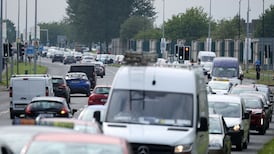Every student of Irish history is taught that the War of Independence began on January 21st, 1919 when members of the Third Tipperary brigade ambushed a police escort travelling to a quarry at Soloheadbeg.
In shooting dead constables James McDonnell and Patrick O’Connell, the ambushers, who included Dan Breen and Sean Treacy, fired the first shots in a war that eventually lead to an independent Irish state.
The target of the ambush was not its escort, but the gelignite destined for the quarry. Breen and Treacy commandeered the cart and rode off with the gelignite.
What happened to it afterwards? According to Séamas Robinson, the real leader of the brigade, it was hidden by Tom Carew, the brigade intelligence officer, so well that nobody knew where to find it, not even the IRA.
READ MORE
Fast-forward more than a century later and the former RTÉ journalist Fergal Keane was clearing out an outhouse on his land in Baltimore, Co Cork, when he came across between 160 and 180 sticks of gelignite.
The explosives were concealed in an earthenware jar, the wall and on the ground.
Could this be the missing gelignite from Soloheadbeg quarry? Mr Keane said the possibility has been raised because the company that made the gelignite, Curtis & Harvey from Kent in England, closed in 1920. It had to be from before or during 1920.
Baltimore is a long way from Soloheadbeg, but it may explain how the RIC were never able to find the explosives despite extensive searches in Co Tipperary.
Mr Keane said he was told by a local garda, who is also a local historian, that this may be the origins of the gelignite.
The consignment has now been disposed of by the explosive ordnance disposal squad from the Irish army. Three controlled explosions were carried out.
According to local historians, the derelict farmhouse, which Mr Keane and his wife Tara Buckley bought six years ago to renovate, was owned by a Denis “Dinny” O’Neill, who was involved in the War of Independence with a number of his brothers.
It was discovered by a man who was doing the stonework on the farmhouse. “We cleared the place and I called out the gardaí. This could have done huge damage had it detonated.”
This would appear to be a different Denis O’Neill from Sonny O’Neill, the man who is alleged to have shot Michael Collins at Beal na Bláth.
[ Who shot Michael Collins? Opens in new window ]
[ How The Irish Times reported the shooting of Michael Collins Opens in new window ]
Mr Keane said it is most likely that Dinny O’Neill, who was involved in the Kilmichael ambush, emigrated to the United States in the 1920s, abandoned the farmhouse and forgot about the gelignite.












